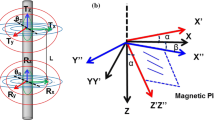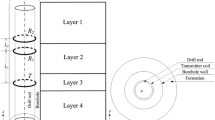Abstract
There exist different response characteristics in the resistivity measurements of dual laterolog (DLL) and logging while drilling (LWD) electromagnetic wave propagation logging in highly deviated and horizontal wells due to the difference in their measuring principles. In this study, we first use the integral equation method simulated the response characteristics of LWD resistivity and use the three dimensional finite element method (3D-FEM) simulated the response characteristics of DLL resistivity in horizontal wells, and then analyzed the response differences between the DLL and LWD resistivity. The comparative analysis indicated that the response differences may be caused by different factors such as differences in the angle of instrument inclination, anisotropy, formation interface, and mud intrusion. In the interface, the curves of the LWD resistivity become sharp with increases in the deviation while those of the DLL resistivity gradually become smooth. Both curves are affected by the anisotropy although the effect on DLL resistivity is lower than the LWD resistivity. These differences aid in providing a reasonable explanation in the horizontal well. However, this can also simultaneously lead to false results. At the end of the study, we explain the effects of the differences in the interpretation of the horizontal well based on the results and actual data analysis.
Similar content being viewed by others
References
Allen, D. F., Anderson, B. I., Barber, T. D., et al., 1993, Supporting Interpretation of Complex, Axisymmetric Invasion by Modeling Wireline Induction and 2-MHz LWD Resistivity Tools: SPWLA 34th Annual Logging Symposium, Calgary, Alberta, Canada, 13-16 June, Paper N.
Anderson, B., Bonnet, S., Rosthai, R., et al., 1992, Response of 2MHz LWD resistivity and wireline induction tools in dipping beds and laminated formations: Log Analyst, 33(5), 461–475.
Chew, W. C., and Wang, Y. M., 1990, Reconstruction of two-dimensional permittivity distribution using the distorted born iterative method: IEEE Transactions on Medical Imaging, 9(2), 218–225.
Chu, Z. H., Gao J., Huang L. J., et al., 2007, Geophysical logging method and principle (first volume): Petroleum Industry Press, China, 114–122.
Darwin, V. E., and Julian M. S., 2008, Well Logging for Earth Scientists (Second Edition): Springer, Netherlands, 213–244.
Faivre O., Barber T., Jammes L., et al., 2002, Using Array Induction and Array Laterolog Data to Characterize Resistivity and Anisotropy in Vertical Wells: SPWLA 43th Annual Logging Symposium, Oiso, Japan, 2-5 June, Paper M.
Fan, Y. R., Wang, L., Li, H., et al., 2014, Numerical simulation and corresponding characteristic analysis of dual laterolog for cave reservoirs: Journal of China University of Petroleum (Edition of Natural Science), 38(6), 40–46.
Gianzero, S., Chemali, R., and Su, S. M., 1989, Induction Resistivity and MWD tools in horizontal wells: 30th Annual Logging Symposium, SPWLA, Denver, Colorado, America, 11-14 June, Paper N.
Gregory, A. N., Walter, L. A., and Gerald, W. H., 1989, Effect of conductive host rock on borehole transient electromagnetic responses: Geophysics, 54(5), 598–608.
Hagiwara, T., 1996, EM log response to anisotropic resistivity in thinly laminated formations with Emphasis on 2-MHz resistivity devices: SPE Annual Technical Conference and Exhibition, 25-28 September, New Orleans, USA, SPE 28426.
Hue, Y., Teixeira, F. L., Martin, L. S., et al., 2005, Three-Dimensional simulation of eccentric LWD tool response in boreholes through dipping formation: Geoscience and Remote Sensing, 43(2), 257–268.
Jin, J. M., 1993, The finite element method in electromagnetics: Wiley-IEEE Press, New York, 8–15.
Koelman, J. M. V. A., Van, d. H. M., Lomas, A. T., et al., 1996, Interpretation of Resistivity Logs in Horizontal wells an Application to Complex Reservoirs from Oman: 16-19 June, 37th Annual Logging Symposium, SPWLA, New Orleans, Louisiana, America, Paper G.
Li, H., Shen, Y. Z., and Zhu, X. F., 2016, Numerical simulation of resistivity LWD tool based on higher-order vector finite element: Journal of Petroleum Exploration & Production Technology, 6(3), 533–543.
Michalski, K. A., and Zheng, D., 1990, Electromagnetic Scattering and Radiation by Surfaces of Arbitrary Shape in Layered Media, Part I: Theory: IEEE Transactions on Antennas and Propagation, 38(3), 335–344.
Nam, M. J., Pardo, D., and Torres-Verdín, C., 2010, Assessment of delaware and gronirgen effects on duallaterolog measurements with a self-adaptive hp finiteelement method: Geophysics, 75(6), F143–F149.
Peng, Z., and Lee, J. F., 2012, Comparisons of heterogeneous multiscale finite element method and localized homogenization process for modeling aperiodic metamaterials, IEEE Antennas and Propagation Society, AP-S International Symposium (Digest). doi:10.1109/ APS.2012.6348588.
Rodr'guez-Rozas, A., and Pardo, D., 2016, A Priori Fourier Analysis for 2.5D Finite Elements Simulations of Logging-While-Drilling (LWD) Resistivity Measurements: Procedia Computer Science, 80, 782–791.
Serry, A. M., Budebes, S. A., and Aboujmeih, H., 2014, What is Rt? logging-while-drilling and wireline resistivity measurements Spotlighted: an offshore case study in Abu Dhabi: 55th Annual Logging Symposium, SPWLA, Abu Dhabi, UAE, 18-22 May, Paper HH.
Tai, C. T., 1971, Dyadic green's functions in electromagnetic theory: Intext Educational Publishers, Scranton, 110–125.
Tan, M. J., Gao J, Zou Y. L., et al., 2012, Environment correction method of dual laterolog in directional well: Chinese J. Geophys. (in Chinese), 55(4), 1422–1432.
Trowbridge, C. W., 1972, Progress in magnet design by computer: Proceedings of the Fourth International Conference on Magnet Technology, Brookhaven, USA, 617–626.
Wang, T., and Fang, S., 2001, 3-D electromagnetic anisotropy modeling using finite differences: Geophysics, 66(5), 1386–398.
Wang, H. M., 1999, Finite element analysis of resistivity logging: PhD Thesis, University of Houston.
Wang, H. M., Liang, C., and Zhang, G. J., 2000, Dual laterolog response in 3-D environments: Petrophysics, 41(3), 234–241.
Wei, B. J., and Liu, Q. H., 2007, Fast algorithm for simulating 3-D electromagnetic inverse scattering in horizontally stratified medium via DTA: Chinese J. Geophys. (in Chinese), 50(5), 1595–1605.
Wei, B. J., Wang, S. S., Ou, Y. F., et al., 2011, Simulating the response of induction logging while drilling tools by vector eigenfunction expansion formulae for dyadic Green’s functions: Chinese J. Geophys. (in Chinese), 54(5), 1391–1401.
Xu, W., Ke, S. Z., Li, A. Z., et al., 2014, Response simulation and theoretical calibration of a dual-induction resistivity LWD tool: Applied Geophysics, 11(1), 31–40.
Yong, S. H., and Zhang, C. M., 2007, Logging data processing and comprehensive interpretation: China University of Petroleum Press, China, 152–284.
Yang, W., and Torres-Verdín, C., 2005, Numerical simulation of dual-laterolog measurements in the presence of dipping, anisotropic, and invaded rock formations: Seg Expanded Abstracts, (1), 344.
Zhang, G. J., 1986, Electrical logging (second volume): Petroleum Industry Press, China, 1–40.
Zhou, J., 2016, LWD/MWD resistivity tool parameters: A Survey sponsored by Resistivity Special Interest Group: http://maxwelldynamics.com/Community.
Zhou, Q., 2008, Log interpretation in high-deviation wells through user-friendly tool-response processing: 49th Annual Logging Symposium, SPWLA, Edinburgh, Scotland, UK, 25-28 May, Paper AAAA.
Zhou, Q., Bean, C., Bell, C., et al., 2007, Practical approach towards modeling and inversion applications in high deviation well interpretation: SPWLA Middle East Regional Symposium, Abu Dhabi, UAE, 15-19 April, Paper Q.
Acknowledgments
The authors extend their appreciation to the anonymous reviewers for their critical and constructive comments and suggestions that greatly improved the manuscript.
Author information
Authors and Affiliations
Corresponding author
Additional information
This Study is supported by the National Science and Technology Major Project of China (Nos. 2016ZX05014-002-001, 2016ZX05002-005-001, and 2017ZX05005-005-005).
Hu Song was awarded his PhD from RIPED in 2014. He is currently a postdoctoral fellow in Petroleum Exploration and Production Research Institute of SINOPEC. His research interests focus on the numerical simulation of horizontal well and data interpretation. He is also interested in complex reservoir log interpretation and evaluation.
Rights and permissions
About this article
Cite this article
Hu, S., Li, J., Guo, HB. et al. Analysis and application of the response characteristics of DLL and LWD resistivity in horizontal well. Appl. Geophys. 14, 351–362 (2017). https://doi.org/10.1007/s11770-017-0635-8
Received:
Revised:
Published:
Issue Date:
DOI: https://doi.org/10.1007/s11770-017-0635-8




